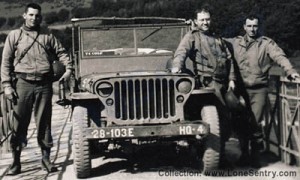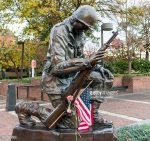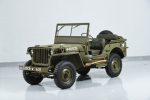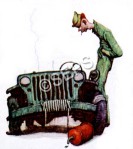Restoring WWII with accuracy

TSF BP 382P HQ
Jeep of the Military Police, Theater Service Forces with complete unit markings. This photograph is most likely a post-war photograph taken during occupation duty.
I’ve created this post to help out a reader now restoring an authentic WWII 1942 Ford GPW. I needed help myself – Matt Underwood, past Editor of “The Voice of the Angels” newspaper of the 11th Airborne Division Association – and I’m proud to say – my friend, came to my rescue.
The only drawback to the Army Manual was that Airborne Divisions had not really developed at the time the text of this book was written, and therefore, the examples of actual vehicle markings on jeeps, etc., of Airborne Divisions are not among the samples/examples in the manual itself. Armies, Corps, and Infantry Divisions, Armored Divisions, and Cavalry Divisions are covered, and all smaller units, but no Airborne Divisions. Everything else about Airborne jeeps are the same as the rest of the Army, with the exception of distinguishing between, say, the 11th Armored Division and 11th Airborne Division. Other than being in two different theaters of war, they are almost the same.
The world of military vehicles, especially American WWII stuff, is a growing field, as old junkers are discovered in barns, landfills, junkyards, and out in the woods, and collectors are buying them and restoring them. When they get their special treasure all completed, they want total accuracy in these unique unit markings to add the final tough of authenticity. So the number of websites featuring vehicle markings has grown rapidly over the past 10 years.

28-103E HQ-4
A jeep from the 103rd Engineer Combat Battalion, 28th Infantry Division photographed on a bridge somewhere in Europe. The unit bumper markings are applied according to regulations and designate the 4th vehicle of the Headquarters of 103rd Engineers, 28th Infantry Division. The windshield carries the addition marking “T4 Cole” in white.
http://www.classicjeeps.co.uk/american-vehicle-markings/
https://blog.kaiserwillys.com/military-jeep-markings
http://www.lonesentry.com/panzer/jeep-markings.html
http://www.kingtigerebooks.co.uk/p/world-war-ii.html
Now back to the last part of the problem. The 11th Airborne Division, like other Airborne Divisions from 1942 to 1944, followed the Army’s Table of Organization & Equipment No. 71, dated 17 Feb 1942. The A/B units in Europe and the States updated this TO&E in Dec 44, but not the 11th or 503rd…not till the early summer of ’45. So almost all of the time the 11th was in combat, it had the same set-up for everything that it always had—at least on paper. I do have a substitute source for part of the data, however, and here’s what I believe your reader will need to know.
I think that for most of the War, MOST of the 11th Airborne’s jeeps and trucks bore vehicle markings like your sepia-colored photo of the jeep from the 188th. Its bumper markings are important in solving this puzzle:
11AB..188-I…………SV8 = 11th Airborne, 188th Infantry, Service Company, 8th Vehicle
No one unit in a WWII airborne division would have such a high number of jeeps unless they were all numbered in a regiment-wide motor pool.
I have some proof that the 511th—being a Parachute Infantry Regiment—had probably all of its vehicles marked for its Service Company, as the motor pool for the whole regiment, which had 3 Parachute Inf. Battalions. It is probable that the 187th and 188th, being Glider Infantry Regiments with only 2 Glider Inf. Battalions each, probably also had all its vehicles marked for its respective Service Cos., which had charge of the motor pool for the whole regiment.
The vehicle allowance for the motor pool of the 511th PIR, seems to TOTAL out as follows: (1) Sedan; (2) Ambulances; (13) 1/4-ton Trucks (which are what Jeeps were usually referred to in official tables); (15) 3/4-ton Trucks; (16) 2-1/2 ton Trucks; and (14) 1-ton Trailers. These totals are for the whole Regiment, but are internally divided between the Service Company’s “HQ Co. Squad”, its “1st Bn. Squad” and 2nd & 3rd Bn. Squads as well, and its own “Transportation Platoon”—-which would be maybe what we would think of as a vehicle “reserve”, or were the vehicles under current repair. It probably allowed a flexibility that couldn’t be had otherwise. What this tells me is that when Col. Haugen needed his staff car, his adjutant called the “motor pool” (the Service Company’s Transportation Platoon) and said “Bring around the Colonel’s staff car.” Then the Colonel’s driver, a NCO from the Transportation Platoon’s “HQ Co. Squad” pulled his staff car up to the Colonel’s CP (command post) and waited. Same with the Colonel’s jeep, etc. When Lt.Col. John Strong, CO of 3rd Bn., needed his jeep, he or his adjutant called up the motor pool and ordered his jeep—-then a driver from the Transp. Platoon’s “3rd Bn. Squad” brought his jeep to Lt.Col. Strong’s CP and waited. When I say “his jeep” it was likely the same one every time, but could be a substitute on any given occasion if the main jeep was getting repaired or cleaned, etc. The pooling of all vehicles into the Service Company may have simply been the best idea to allow flexibility whenever a vehicle was needed on short notice.

From late 1940 to February 1945, markings were to be made in blue-drab. This type of color scheme would prevent enemy intelligence from gathering and identifying military markings as the two colors were hard to distinguish from one another when viewed in black and white photographs. The official color of these markings was changed to flat white in February 1945, but the reserves of blue-drab paint were used until exhausted.
In other words, ALL the jeeps and other vehicles would have Service Co. marks on the bumpers, regardless of who in the Regiment was using them. Therefore, the 511th would have a fleet of jeeps marked SV1 through SV13. I am GUESSING (for now) that the 187th and 188th had similar systems, which would explain your photo of a 188th jeep marked SV8. I am guessing that if the system holds, the 188th was only allotted 9 jeeps total.
Anyway, I will get back to you on that.
As to 11th Division HQ, I’m not sure yet as to its markings. Probably they had their own vehicles, but unsure as yet. If so, Gen. Swing’s jeep would probably have been bumper marked like this:
11ABX………………..HQ1 = 11th Airborne Division, HQ Company, 1st Vehicle
As always, these are 3″ tall letters, and the center of the bumper may or may not have a star painted on—it is the US star for all vehicles, found all over most other big surfaces. The bumpers often had them to start with, and as paint wore off and was repainted, sometimes the bumper stars were skipped, leading to the frequent blank space in the center where a star once was.
MATTHEW UNDERWOOD
Bookbinder/Conservator, Boyce Centennial Library,
The Southern Baptist Theological Seminary;
Editor Emeritus, Voice of the Angels,
11th Airborne Division Association
********** **********
The 11th Airborne uniform examples
################################################################################################################
Click on images to enlarge.
Military Humor –
################################################################################################################
Farewell Salutes –
Dominic “Mickey” Bria – Smithers, SC; US Army, Korea, 187th RCT ‘Rakkasans’
William Conklin – Stony Point, NY; US Army, 11th Airborne Division
George D’Arcy – Liverpool, ENG; British Army, WWII, ETO, CBI & Africa, 2/South Lancashire Regiment
Homer Godair – Griffithville, AR; US Army, 11th Airborne Division
Scott Humbird – Brentwood, CA; US Army, WWII, PTO, Malaria Control Unit
Charles Pittman Sr. – Pensacola, FL; USMC, Vietnam, Silver Star, Distinguished Flying Cross, Purple Heart, Lt.General (Ret. 40 y.)
William Sartain – Mineral Wells, TX; US Merchant Marines, WWII, PTO
Mary Sweeney – Nanticoke, PA; US Army Air Corps WAC; WWII, Medical/Surgical Tech.
William Taylor – Grant, AL; US Army, Korea, 187th RCT “Rakkasans’
William Whiteman – Hood River, OR; US Navy, WWII, Korea, Vietnam, Lt. Commander (Ret. 27 y.)
###############################################################################################################
Posted on February 24, 2020, in First-hand Accounts, Home Front, Post WWII, WWII and tagged 11th airborne, 1940's, Army, family history, History, Military, Military History, military vehicles, Pacific War, Restoration, WW2, WWII. Bookmark the permalink. 95 Comments.












A remarkable and commendable post gp, I think every soldier must have been qualified as a visual linguist in the war days, to decipher all markings would have been an incredible feat.
LikeLiked by 2 people
You’re quite right, Ian. And they had to do it for all the Allies, not just their own.
LikeLiked by 1 person
What caught my attention was the photo of “11th A/B Div. repairs a truck in Japan.” It had to have been posed. All seven of those men couldn’t have fit in that small truck?
LikeLiked by 2 people
Quite possible, Liz, but the caption on the picture didn’t elaborate. Many of the vehicles in Japan by that time were running on coal and broke down repeatedly – I think that might have been the point the cameraman was making.
LikeLiked by 1 person
Yes, that would make sense. I’ve never heard of a coal-fired engine, though.
LikeLiked by 1 person
haha, I don’t think the soldiers did either!
LikeLiked by 2 people
🙂
LikeLiked by 1 person
Now that’s a lot of technical information, G. Had my brain reeling. Our son-in-law’s dad restores antique vehicles to their original state and I can attest to the incredible amount of detail that is involved. –Curt
LikeLiked by 2 people
I was so shocked by the response here. I had thought it would be received by a limited audience – but this isn’t the first time I was wrong, eh? 🙂
LikeLike
The kind of wrong you want to be, G! 🙂
LikeLiked by 1 person
🙂
LikeLike
Reblogged this on depolreablesunite.
LikeLiked by 2 people
Thank you, Rick!
LikeLike
After the War the Jeep became a very common on farms as a workhorse. My uncle had one. It was better for them to be used that for great trenches to be dug and for them to be buried.
LikeLiked by 2 people
Thank you for adding to the post, Paol. You might say your uncle ‘recycled’ the equipment, eh?
LikeLiked by 1 person
Very interesting post!
LikeLiked by 2 people
Thank you. I realize this post had a limited audience, but people have sure admired the commitment involved!
LikeLiked by 1 person
Yes, they did!
LikeLiked by 2 people
I admire the commitment to historical accuracy.
LikeLiked by 2 people
I know this project will take a while, but I’m still going to anxiously await the finished product!!
LikeLiked by 1 person
The jeepney – the Filipino adaptation of the WW2 jeep as one of your followers mentioned above – is still operating here! Different engines and bodies now of course but still based on the chassis and look of the originals plus the garish designs.
LikeLiked by 2 people
I’ve seen pictures of them online, but still prefer the original! Thanks for stopping by!
LikeLiked by 1 person
There is enormous interest nowadays in the uniforms and equipment of WW2. We went to what used to be RAF East KIrkby a few years back and saw a day long recreation of a day in 1944. Everybody seemed to like it, with the ladies’ strange hair-does and the men in all kinds of RAF and Eighth Air Force uniforms. Personally though, I can’t imagine why anybody would want to come along as a German, which a few people had done.
I never thought at the time, but perhaps they were Germans?
LikeLiked by 2 people
hahaha, you just might be right!! I love re-enactments of any kind – it keep the past alive and it’s the best form of education.
LikeLike
Absolutely fascinating read, and just goes to show that details are important
LikeLiked by 2 people
Another piece of history saved – it doesn’t get any better than that!!
LikeLiked by 1 person
Most definitely.
LikeLiked by 1 person
In the Philippines, they remodeled this military car to what we call “owner type jeep” and I used to have one myself and it’s manual but my father and brother drive it as I can only drive automatic, unfortunately. PH has a lot of memorabilia from WWI & WWII.
LikeLiked by 2 people
This jeep in question is in Europe, owned by a serviceman of his own country. So, I was extremely honored to be asked to help out with certain details.
LikeLiked by 1 person
What an interesting, yet difficult, project this would be. I can see them driving by in a parade now.
LikeLiked by 2 people
I admire the determination for accurate details. I was so proud to be asked to help!
LikeLiked by 1 person
I’m not much into restoration, so didn’t read this carefully. Are going to try to make Mary’s retirement? I just can’t – need to be in Eau Claire. Patty and I heading to the Destin FL area next week – looking forward to getting out of the cold weather for awhile! Tom
Tom McCarthy
LikeLiked by 2 people
Reblogged this on John Cowgill's Literature Site.
LikeLiked by 2 people
Thank you, John!
LikeLiked by 1 person
You are very welcome.
LikeLiked by 1 person
I once worked on a boat owned by a guy who restored vintage cars, and believe me — his attention to detail was nearly overwhelming. I think it takes a certain personality to take on a project like this; a lot of patience is needed, as well as knowledge.
Speaking of finding and restoring, I think you might enjoy this article I found today in the Smithsonian about the discovery of some WWII planes in the Pacific.
LikeLiked by 2 people
Outstanding article, Linda, thank you! I often include those servicemen brought home by the recovery teams in my Farewell Salutes.
LikeLike
… heh heh … So are you doing “Gear Head Tuesday” for my blog on Monday now?
Inquiring minds want to know!
😂😊
LikeLiked by 2 people
I wish I had a quick wit like you and your contributing friends!!
LikeLike
Another excellent and informative posts, GP. Those old jeeps are epic.
LikeLiked by 2 people
Thank you – and I know – I wish I had one!
LikeLiked by 1 person
They are doing a great work, even with much more greater efforts. Thank you for the very interesting information, GP! Hope you will have a beautiful week. Michael
LikeLiked by 2 people
Thank you, Michael. You might like to know that the Jeep in question here is in Belgium.
LikeLiked by 1 person
Oh, nice to hear, GP. Thank you! Michael
LikeLiked by 1 person
I wish I was restoring one of these old vehicles. nice job, GP.
LikeLiked by 2 people
You and me both, John.
LikeLiked by 1 person
Brings back a lot of memories, GP. Thanks.
LikeLiked by 2 people
I hope they were fond ones, Don. Thanks for coming by!
LikeLiked by 1 person
Always a joy to stop by – I learn something new with everyone of your posts.
LikeLiked by 2 people
I’m glad this one wasn’t too boring for you. I knew it had a limited audience of interest, so I am thrilled with the response!
LikeLiked by 1 person
Actually your post brought back great memories. I grew up in Brazil in the 1950s in a rural location with jungle roads that needed a Jeep. My father was a veteran of WWII who knew the benefits of having the type of vehicle that he knew from his army days. I remember when the rivers flooded and those vehicles got us through. What an adventure!
LikeLiked by 1 person
Fantastic! Thanks for your story with the jeeps!
LikeLiked by 1 person
I’ve been researching a WWII Med Corps Doctor lately, and have come across a lot of amazing websites that feature TONS of great photos of various aspects of each theater. I’ve also discovered that there are a few (not many) old news reel clips on You Tube where you can find certain things you might be looking for. It’s often difficult when you have a black and white photo to research what the colors of the marking might have been, though. I hope your reader/friend finds all he needs to restore that amazing GPW.
LikeLiked by 2 people
I appreciate your help, Rachel. For some reason I never thought of Youtube!! Thanks!
LikeLiked by 1 person
It’s actually pretty weird how I came across all that I did — i.e., NOT what search terms I used. Also, try the National Archives photos.
LikeLiked by 1 person
Some I can get and others seem to be in a program that will not allow my computer to see them. The restorer seems to be pleased – he is very happy and grateful for everyone’s help.
LikeLike
Ah, the old Jeep. I went out to NTC (Ft. Irwin CA) with 1st ID, and 501st MPs was still using the old Jeep then. Lot of fun playing Rat Patrol in it. Shortly afterwards we traded them in for the Hummer.
LikeLiked by 2 people
Similar engineers, I believe? I envy you “playing” Rat Patrol with yours!
LikeLiked by 1 person
Make that 1st MPs. 501st hadn’t happened in my life yet.
LikeLiked by 1 person
One of the reasons I own a Jeep, a tough vehicle with a history. Great photos on your blog, GP.
LikeLiked by 2 people
Thanks! I know the restoration will be a while, but I can’t wait to see it!
LikeLike
Wishing the best to your reader restoring that vehicle! I also enjoyed the slide show.
LikeLiked by 2 people
Thank you, Lavinia. Sarge3 already said it was superb and that thrilled me to no end!
LikeLiked by 1 person
The technicalities are beyond my scope, but I think one would be marvellous to own and I enjoyed the uniform gallery.
LikeLiked by 2 people
I knew this would have a limited audience, so I’m very glad I put in something you liked, Derrick. I appreciate you telling me.
LikeLiked by 1 person
Reblogged this on Dave Loves History.
LikeLiked by 2 people
Thank you, Dave!
LikeLike
Years ago I knew someone who had an Army surplus Willys Jeep. Not very adept at shifting gears would say above the whine, “if ya can’t find ‘em, grind ‘em.” They could take amazing amounts of abuse and still run.
LikeLiked by 2 people
They were an incredible creation. I don’t know know how a lot of things would have gotten done without them.
LikeLiked by 1 person
Come to think of it, I haven’t seen too many photos of jeeps in all of the WWII books I read. I saw tanks all the time. I know they were around since there were plenty of them after the war that Filipinos turned into garish-looking jeepneys.
LikeLiked by 2 people
I’ve seen the jeepneys on line, at least they came to good use! lol I know the restoration is going to take a while, but I can’t wait to see it!
LikeLike
Drove a Jeep for the Batallion XO while stationed in Germany with the 2/22 Inf (Mech) from 79 to 81. They sure didn’t change much. I seem to remember being told that the carburetor was made by the Singer Sewing Machine Co. Don’t really know if that was true or not.
LikeLiked by 2 people
I don’t know about Singer and the carburetors, that might have been like the old line, “Did you get your driving license out of the Sears catalog?” but, I wouldn’t be surprised if they did – they were great at making WWII weapons!!
LikeLiked by 1 person
To find a well-preserved WW2 vintage jeep must be like finding a treasure. I once owned 1954 Pontiac in near mint condition, which was given to me as a farewell gift by my principal in 1966. It would be worth a fortune if it was found today in the same condition. Interesting post, GP!
LikeLiked by 2 people
Thank you, Peter. I love seeing the past restored. I was thrilled to be of assistance in some small way.
LikeLiked by 1 person
Great pictures today, and a wealth of information for the restoration project!
LikeLiked by 2 people
Thank you, Dan. I figured this post had a slim audience, only restoring projects and model kit hobbyists – so I thank you for stopping in!
LikeLiked by 1 person
I have a friend who is an avid hobbyist. I know how important these details are.
LikeLiked by 1 person
Thank you.
LikeLiked by 1 person
This is the sort of invaluable information beloved of WW2 re-enactors.
It is also a popular pastime in the UK.
https://www.ww2lha.co.uk/
Best wishes, Pete.
LikeLiked by 2 people
I thought model kit people might like it as well. You know I feel re-enactors are the best educators for history and I hope this helps in some way.
LikeLiked by 1 person
Wonderful, GP! BTW, I finally posted about Norman Rockwell this morning, with a link to you.
LikeLiked by 2 people
Thank you very much!! That was a wonderful post, that I see I am not alone in lovin’ it! Rockwell helped our country back then and I believe he still does.
LikeLiked by 1 person
You’re welcome, GP.
LikeLiked by 1 person
GP, I love this article and the cartoons. It reminds me of being an MWR specialist in Hungary during Operation Joint Guard. It was important to be friends with the motor pool Sargeant. Because we were responsible for the television sets and other off duty entertainment, he made sure there was always a nontactical vehicle available for us to drive.
I saw my first WWII reenactment at the Ft Myer Library in Arlington, VA when a group of Renactors asked to do a set up a camp on the grass in front of the library. The enactors in German Army uniforms were part of the group. An elderly French lady was using the pool since this was Memorial Day weekend and the pool had just opened. She had a flashback to WWII and almost jumped out of her skin when she was German soldiers with rifles walking around the outside the library. To make a long story short, equipment like a jeep or the ability to set up a field post office really pops a reenactment set up.
LikeLiked by 2 people
Love the story! I can just imagine that woman ready to take off running when she spotted the Germans!! I’m glad this post brought back fond memories for you too!
LikeLiked by 1 person
It was a sweet trip down a path of memory lane I haven’t traveled in a while. 😁👍💞
LikeLiked by 1 person
That makes me happy!
LikeLiked by 1 person
Superb!
I have also found a photo in a Japanese book about jeeps in the pacific :
11ABX RCN3 seen during a parade with jeeps in Japan.
Think this was the Provisional Recon Platoon.
LikeLiked by 1 person
It appears to be. I hope Matt and I were able to be of use to you in your terrific project! I wish you the best of luck and don’t be a stranger!
Your wife may wish to pass the time talking to a fellow Filipino, Rosalinda. Also a blogger, she recalls her father’s stories of the war years, history and assorted other details. A very nice lady.
LikeLike
I received the photo!! It’s fantastic! Thank you for sending it to me!
LikeLiked by 1 person
Love the slide show!
LikeLiked by 2 people
Thank you. I’m glad!
LikeLiked by 1 person
Thank you very much, Ian.
LikeLike
Pingback: Featured Blogger: Restoring WWII with accuracy // Pacific Paratrooper #AceHistoryDesk reports | ' Ace Worldwide History '